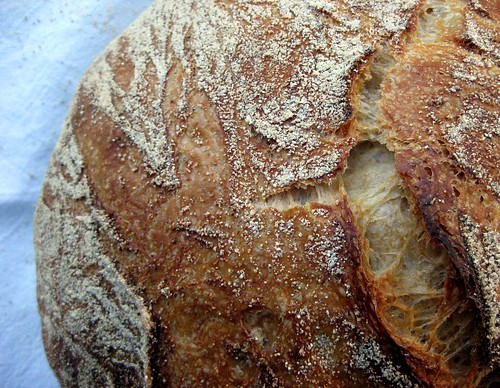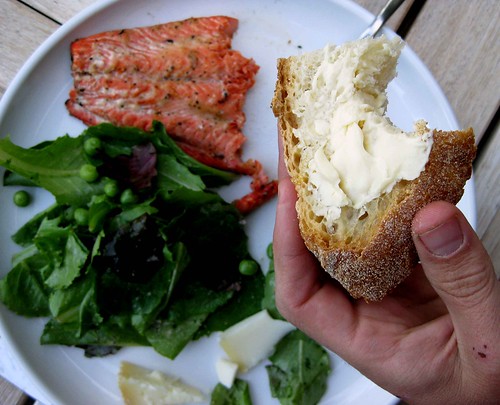
I have never been one for the bandwagon.
I acquired my first cell phone only two years ago. I still do not have a Facebook page. In the early nineteen-nineties, the New Kids on the Block craze completely passed me by, and in the early two-thousands, despite a rather long pair of legs, I have managed to keep my jeans untucked from my leather boots. I don’t set out to be contrary. Back in junior high, when my friends started drinking coffee in order to “acquire a taste” for it, I did my best to join in. But the bitter brew never lived up to its aroma, and I had to abandon the cause. The trouble is, try as I might, if I don’t find something appealing, I just can’t fake it.
There’s a certain romance in dancing to the beat of a different drum. It seems honest and brave. But the downside is that, sometimes, I just plain miss out on things.
In 2006, Mark Bittman published Jim Lahey’s no-knead bread recipe in his New York Times column, The Minimalist. The result was a bread-baking revolution. Would-be bakers everywhere dusted off their cast iron pots, and produced the crusty, airy loaves that dreams are made of. When their cookware couldn’t take the heat, these apron-clad revolutionaries took to the streets, looting and pillaging, swiping Le Creuset knobs from sales displays with their still-floury hands.
Time and again, I heard about the virtues of Lahey’s no-knead bread. But frankly, it just never occurred to me to try it. Why, I reasoned, would I want a no-knead bread recipe, when I already have a bread recipe that I love? When I don’t mind the kneading one bit and, in fact, actually enjoy it? (Yes, I realize that this “reasoning” is glaringly empty of reason. I tend to be overly attached, clingy even, to my favorite tried-and-trues. I’m working on it. Just don’t ever make me part ways with Martha’s pâte brisée, okay?)
Years passed, and the most celebrated no-knead bread of all time simply fell off my radar.

A funny thing happens when you write a blog like this one. You go on a little about food, post a few photographs, and soon everyone on the planet has just the recipe for you. It’s my favorite perk of the job. Most people are content to suggest a recipe in an e-mail, to dictate it over the phone, or to scribble it down and slide it across the table once the plates have been cleared. A few months back, our friend, Rich, left a link to Lahey’s no-knead bread recipe in a comment right here on Sweet Amandine. But he didn’t stop there. Dear Rich went so far as to leave the country and lend us his lake house, to slip the printed recipe between the pages of the The Joy of Cooking on the counter and – here’s the kicker – to tuck a Le Creuset pot into the bottom drawer by the oven. Rich, do Martha and the kids know that your summer trip was just a ruse to get me into your kitchen, the stage you set so perfectly for the baking of Lahey’s no-knead bread? If not, your secret’s safe with me.
Four crackly-crusted loaves later, I am so securely on board, I have picked up a trumpet and joined the band. For the uninitiated (that is, assuming another soul exists who has not yet baked this bread), Lahey’s secret weapons are time and a covered heavy pot. Mixing together the dough takes only about a minute. No joke. Instead of kneading it to develop the gluten, a long fermentation process – 18 hours – does the work for you. The trick behind the crisp, golden crust is the moisture in the dough. It transforms the covered heavy pot into a miniature steam oven, which mimics the larger steam ovens in which professionals and artisans bake their loaves. Suddenly, that elusive shattery crust is not only within reach, it’s tumbling out of your very own oven.

It’s really something.
If you have held out this long, dear reader, and have not yet enjoyed this recipe, let me gently suggest that the time has come to have at it. Bake this bread. You’ll see. Some wagons are indeed worth the hop.

No-Knead Bread
Adapted from Jim Lahey at the Sullivan Street Bakery via Mark Bittman at New York Times
3 c. all-purpose or bread flour, more for dusting
1/4 t. instant yeast
1 1/4 t. salt
1 1/2 c. water
Cornmeal or wheat bran as needed
1. In a large bowl, stir together the flour, yeast, and salt. Add the water, and stir until blended. The dough will be shaggy, sticky, and loose. Cover the bowl with plastic wrap. Lahey says to let the dough rest for at least 12 hours, preferably about 18, at warm room temperature (about 70 degrees). I have had the best results waiting 18-20 hours.
2. The dough is ready when its surface is dotted with bubbles. Lightly flour a work surface and place the dough on it. Sprinkle the dough with a bit of flour. Grab the left and right sides of the dough and fold them into the center. Then do the same with the top and bottom sides of the dough. Cover loosely with plastic wrap (you can use the same sheet of plastic that covered the bowl) and let rest for about 15 minutes.
3. Using just enough flour to keep the dough from sticking to your work surface and your fingers, gently and quickly shape the dough into a ball. Generously coat a cotton towel (not terry cloth - it will stick) with flour, wheat bran, or cornmeal. (I use cornmeal.) Flip the dough onto the towel, seam side down. Dust the top with more cornmeal (or flour, or bran). Cover with another cotton towel and let rise for 2-3 hours. When it is ready, the dough will be more than double in size, and will not readily spring back when poked with a finger.
4. At least half an hour before the dough is ready, heat the oven to 450 degrees. Put a 4-6 quart heavy covered pot (cast iron, enamel, Pyrex, or ceramic)* into the oven as it heats. When the dough is ready, carefully remove the pot from the oven. Slide your hand under the towel and turn the dough over into the pot, seam side up. If it looks like a giant, ugly blob, you're right on track! Shake the pot once or twice if the dough is unevenly distributed. It will straighten out as it bakes. Cover with the lid and bake for 30 minutes. Then, remove the lid and bake for another 20-30 minutes, until the loaf is beautifully browned. Turn out onto a rack, and enjoy the lovely crackling as it cools!
Yield: One 1 1/2 pound loaf.
*I read up a little about the issue of plastic knobs that may or may not be heat resistant to 450 degrees. Some people report that the plastic knobs on their Le Creuset pots have cracked, melted, or even exploded (!) in the very hot oven. Others claim to have had no trouble whatsoever. To play it safe, I simply unscrewed the plastic knob from the pot and stopped up the hole with foil. Then, I carefully slipped the top on and off with oven-mit-protected hands. Another option is to order a stainless steel replacement knob from Le Creuset. Or, find a heat-safe knob (drawer pulls, I've been told, do the trick) at your local hardware store.
